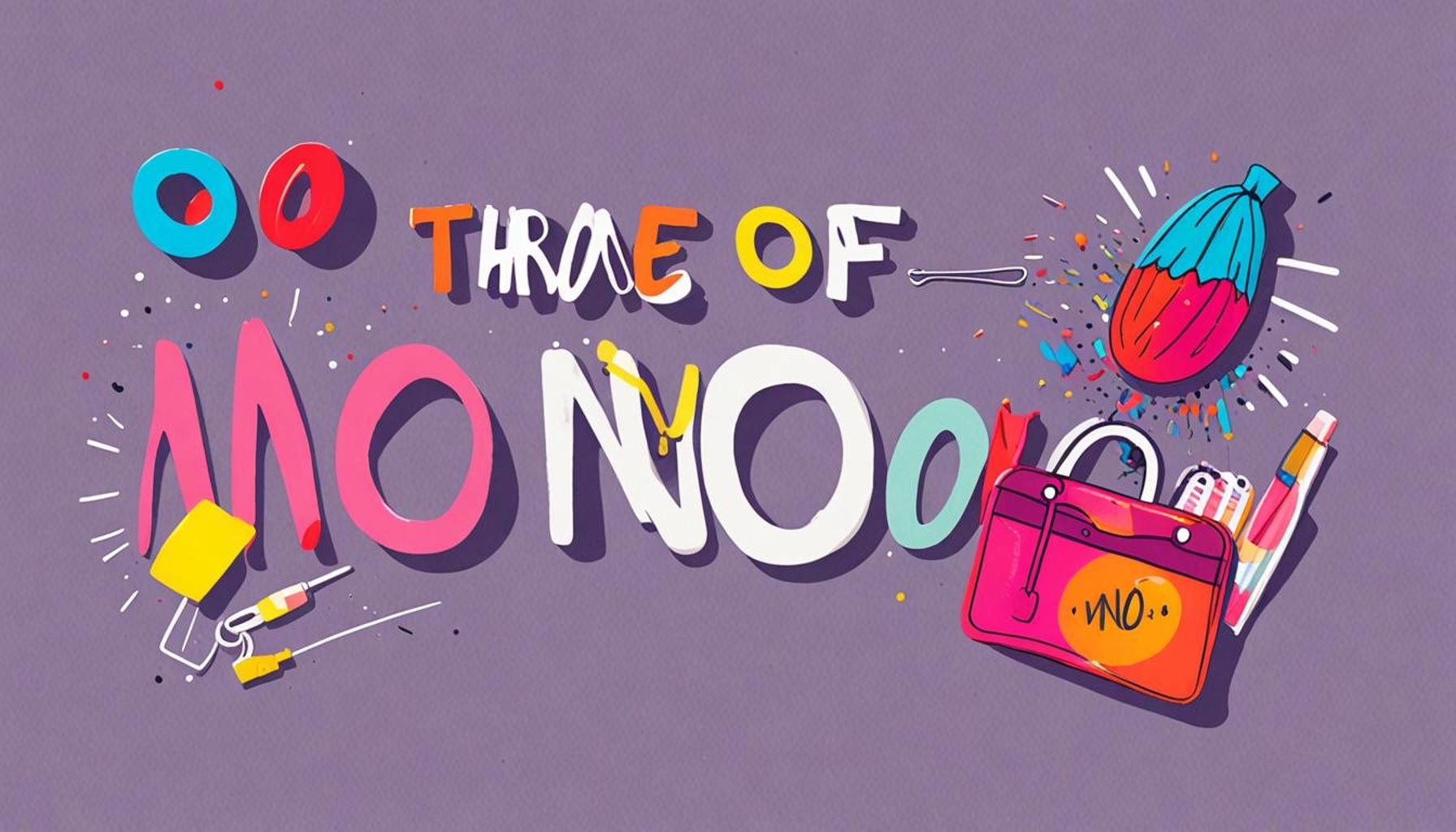The Art of Saying No: How to Prioritize Commitments in a Minimalist Lifestyle

The Importance of Establishing Boundaries
Today’s fast-paced society bombards us with countless demands, often making it difficult to discern which commitments genuinely deserve our time and energy. The ability to master the art of saying no becomes vital in navigating these pressures. While it may feel uncomfortable at first, empowering yourself to decline additional responsibilities can significantly enhance your overall well-being and quality of life.
Why Saying No Matters
Establishing clear boundaries isn’t merely a tactic for time management; it is foundational to preserving your mental and emotional health. Consider the following essential reasons for embracing this practice:
- Reduces stress: By accepting fewer commitments, you free yourself from the burden of overextending and reduce anxiety. Research has shown that high stress is linked to various health issues, making stress reduction crucial for long-term wellness.
- Increases productivity: Focusing on a select number of tasks allows for deeper engagement and creativity, resulting in higher quality outputs. For instance, corporate studies indicate that employees who limit their projects typically showcase improved performance metrics.
- Enhances self-awareness: Learning to say no requires introspection, prompting you to examine your priorities and values. This essential process can clarify what is genuinely important to you, fostering a sense of purpose and direction.
Key Aspects of Prioritizing Commitments
Transforming your approach to obligations hinges on effective prioritization. To streamline this process, consider the following elements:
- Evaluating your core values: Take time to reflect on what aligns with your personal or professional goals. For example, if family is at the heart of your values, focus on commitments that strengthen those relationships.
- Identifying energy drains: Pay attention to which commitments leave you feeling depleted. It may be a weekly social gathering that no longer excites you or a project at work that feels misaligned with your passions.
- Creating a “yes” filter: Establish criteria that clarify what genuinely excites or benefits you. This filter can involve assessing how potential commitments align with your long-term goals and personal growth.
By honing the skill of saying no, individuals can cultivate a more intentional lifestyle, leading to greater fulfillment. Practical strategies such as setting boundaries, reassessing prior commitments, and fostering self-discipline can dramatically change how one interacts with the world. Ultimately, embracing simplicity through boundaries can pave the way for a liberated, minimalist existence that encourages mindfulness and clarity in decision-making.
If you’re standing at a crossroads, contemplating whether to accept an overwhelming new project at work or attend every social event, remember that every commitment has the potential to divide your attention. Prioritizing wisely empowers you to safeguard your time, ensuring that when you say yes, it’s to what truly inspires you. Embrace the challenge of simplification—it may just lead to the freedom and joy you’ve been seeking.

DON’T MISS OUT: Click here to discover more organizing tips
Strategies for Mastering the Art of Saying No
Embracing the minimalist lifestyle doesn’t just involve decluttering physical space; it encompasses a holistic approach to how we allocate our time and emotional bandwidth. To effectively prioritize commitments, it is essential to develop practical strategies for saying no. Below are some actionable techniques that can empower you to streamline your obligations and embrace a more intentional way of living:
1. The Power of Reflection
Before enunciating a firm “no,” take the opportunity to reflect on your current commitments. Are they aligned with your values? Do they foster a sense of purpose? Engaging in this introspection can illuminate which activities are worth your time. Consider jotting down your current obligations and rating them based on level of fulfillment or alignment with your goals. This will help you visualize where you might need to cut back.
2. Practice Saying No
Just like any skill, saying no becomes easier with practice. Begin in low-stakes situations to build your confidence. For example, gracefully decline an invitation for a casual coffee catch-up. Use phrases like, “I appreciate the invite, but I need to focus on my priorities right now.” Over time, you’ll become more comfortable asserting your boundaries, which can translate into tackling more significant commitments without hesitation.
3. Adopt a Response Technique
If saying no feels daunting, develop a structured response technique. This might include:
- The “Sandwich” Method: Start with a positive statement about the invitation, follow with your refusal, and close with appreciation. For example: “I’m grateful for the invitation and it sounds fun, but I have to decline due to prior commitments. Let’s catch up soon!”
- Use “I” Statements: Frame your responses from your perspective, emphasizing your own needs without blaming others. For instance: “I can’t take on additional work at this time; my plate is full.”
- Keep it Simple: You don’t owe anyone a lengthy explanation. A succinct: “I can’t, but thank you for thinking of me” can often suffice.
4. Knowing Your Limits
Understanding your own limits is crucial for prioritizing commitments effectively. Assess how much you can realistically handle without experiencing burnout. Experts suggest adopting the 80/20 rule, which posits that 80% of your results come from 20% of your efforts. This means you should evaluate which commitments yield the most impact, allowing you to allocate your time meaningfully.
By integrating these strategies into your life, you’ll not only become adept at saying no, but you’ll also see your relationships and personal projects flourish. A well-placed no can be a resounding yes to your own well-being, paving the way for a richer and more fulfilling minimalist lifestyle.
| Advantages | Details |
|---|---|
| Clarity in Prioritization | Embracing a minimalist lifestyle enhances clarity in assessing commitments, allowing individuals to easily determine what truly matters. |
| Reduced Stress | Saying no to unnecessary obligations decreases overall life stress, leading to higher productivity and increased personal satisfaction. |
| Enhanced Relationships | Focusing on fewer but more meaningful commitments fosters deeper connections, allowing for more authentic relationships with friends and family. |
| Time for Self-Reflection | A minimalist approach encourages self-reflection and mindfulness, providing time to explore personal interests and personal growth. |
In adopting the art of saying no, individuals find themselves living a more fulfilled and intentional life. This approach not only paves the way for a more manageable calendar but also encourages individuals to engage in activities that truly resonate with their values and passions. By prioritizing commitments, you actively create space for what matters most, which is a cornerstone of a successful minimalist lifestyle. Discovering the balance between obligations and personal desires leads to enriched life experiences, fostering a sense of freedom and clarity that many seek but few achieve. When you master the art of prioritization, you are not just saying no; you are saying yes to a life of quality and purpose.
DISCOVER MORE: Click here to learn about maximizing your space
Building Resilience Through No
The journey to mastering the art of saying no is not just about declining requests; it’s about empowering oneself to foster an intentional life. In a world that constantly demands our attention, building resilience becomes essential. Developing the ability to say no allows us to defend our mental space and emotional resources, ultimately leading to healthier relationships and a greater sense of fulfillment.
5. Embrace the Fear of Missing Out (FOMO)
The fear of missing out can be a significant barrier to effective boundary-setting. In an age where social media highlights every event and achievement, it’s easy to feel pressured to participate in every opportunity. However, recognizing that declining an invitation or opportunity does not translate to missing out on life can be liberating. Instead, view it as an opportunity to engage more fully with commitments that truly resonate with you. Find solace in the idea that each “no” is a “yes” to personal growth, well-being, or existing obligations.
6. Prioritize Quality Over Quantity
Sustainable commitments often stem from prioritizing quality over quantity. Consider this: when you agree to too many engagements, you dilute the impact you can have in any single situation. Instead of spreading yourself thin across various events or projects, focus on those that genuinely excite you or align with your goals. By deliberately choosing fewer, more meaningful engagements, you enhance the quality of your interactions and experiences, leading to deeper connections and enhanced fulfillment.
7. Create a Commitment Inventory
A practical approach to managing commitments involves regularly reviewing and updating what is on your plate. Compile a “commitment inventory” where you list all your ongoing projects, activities, and involvements. Evaluate which ones energize you and which ones drain you. Consider the impact of each—both on your time and mental well-being. As seasons change and life demands shift, updating this inventory encourages a mindset aimed at intentionality, allowing you to confidently say no to obligations that no longer serve you.
8. Setting Up Decision-Making Frameworks
Having a decision-making framework can empower you to quickly assess whether to accept or decline a commitment. One effective model is the Three Questions Method: When approached with a new opportunity, ask yourself:
- Does this align with my core values?
- Will this commitment enhance my overall happiness or well-being?
- Is this truly something I can commit to without overextending myself?
Using these guiding questions will help filter requests and resist the impulse to say yes out of obligation. This structured approach fosters clarity in decision-making, allowing you to honor your time and energy effectively.
9. The Art of Delaying Your Response
In many cases, we feel pressured to respond immediately to invitations or requests. However, practicing the art of delay can enhance your ability to say no by providing you with the necessary time to evaluate the legitimacy of the commitment. When faced with a proposal, simply state, “Let me take some time to think about it.” This pause enables you to reflect on your priorities and make a decision that aligns with your minimalist lifestyle, rather than succumbing to impulsive reactions.
Incorporating these techniques into your life will help foster a culture of self-respect and self-care, solidifying your position in the minimalist lifestyle. Over time, saying no becomes not just a protective measure, but a profound affirmation of who you are and what you value.
DIVE DEEPER: Click here to discover powerful emotional techniques
Conclusion: Embracing the Power of No
In a world brimming with opportunities and incessant demands, mastering the art of saying no is pivotal for nurturing a minimalist lifestyle. By understanding the significance of prioritizing commitments, we not only protect our time and energy but also enhance our overall well-being. Acknowledging the value of saying no enables us to filter out distractions and focus on experiences that truly align with our core values.
When we embrace the fear of missing out (FOMO) and shift our mindset towards valuing quality over quantity, we discover a new sense of freedom. Regularly updating a commitment inventory helps maintain clarity in our lives, allowing us to reaffirm our decisions continuously. Moreover, establishing decision-making frameworks, like the Three Questions Method, equips us with the tools needed to evaluate commitments effectively. These practices are not merely logistical; they are transformative, guiding us toward a lifestyle that prioritizes intentional living.
Ultimately, learning to say no is an affirmation of self-respect and self-awareness. It paves the way for deeper connections and greater personal fulfillment. As we cultivate this crucial skill, we create room in our lives for what matters most, fostering resilience against the pressures of modern society. So, the next time an opportunity arises, remember—each no is a committed yes to living in alignment with your values. It’s time to reclaim your time, enhance your well-being, and embrace the power of no as an art form in your journey toward a minimalist lifestyle.


